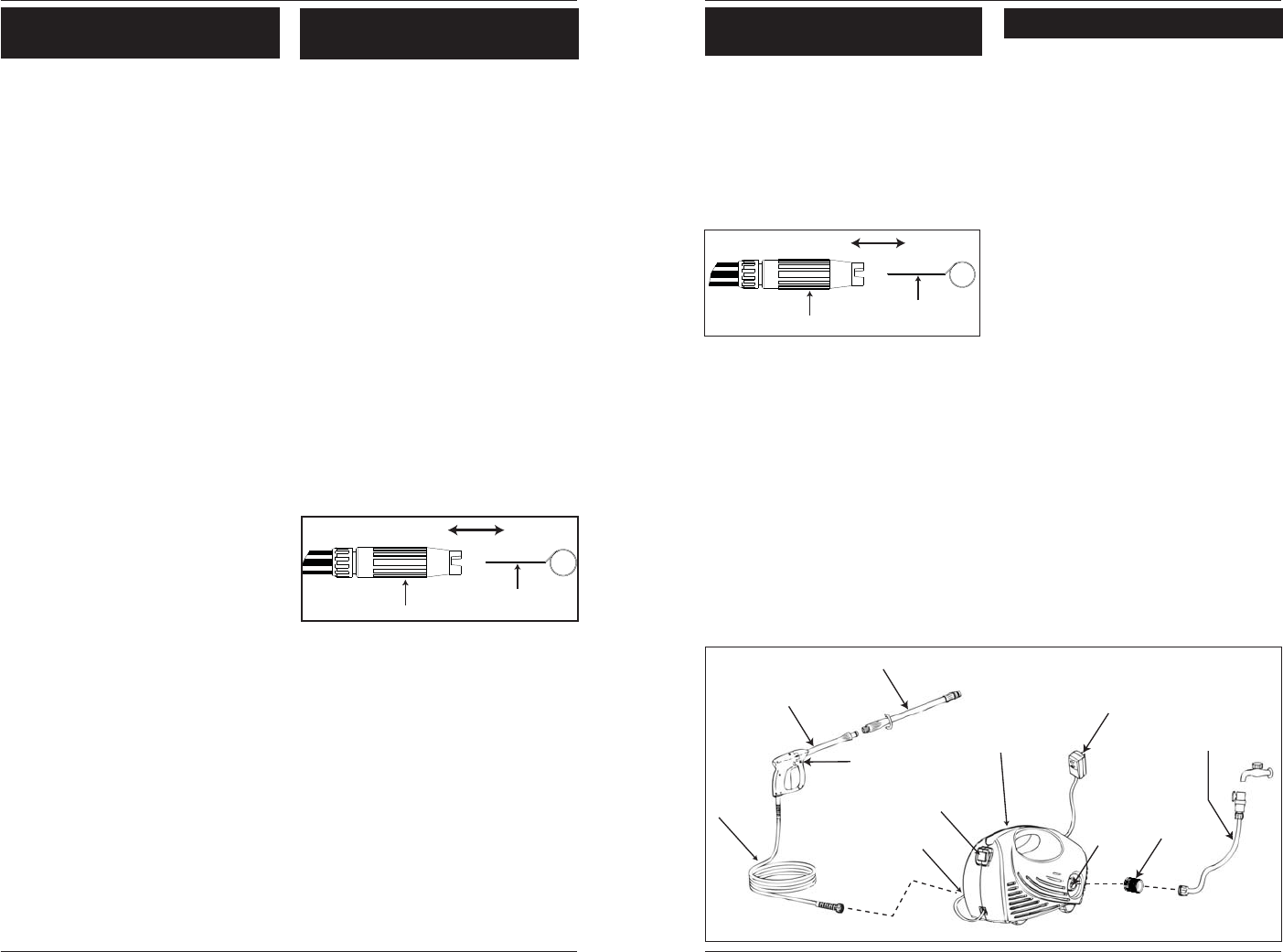Replacement Part List

Sp-8
Cómo Evitar Dañar Las
Superficies
Instrucciones de uso
El daño a las superficies de limpieza
ocurre porque la fuerza de impacto
del agua supera la durabilidad de la
superficie. Puede variar la fuerza de
impacto controlando el patrón en
abanico de la boquilla, el ángulo de la
boquilla con respecto a la superficie de
limpieza y la distancia entre la boquilla
y la superficie de limpieza. Nunca utilice
un chorro angosto de alto impacto ni
una boquilla turbo sobre una superficie
propensa a ser dañada. Evite rociar las
ventanas con un chorro angosto de
alto impacto o con una boquilla turbo.
Hacer esto puede quebrar la ventana. La
forma más segura de evitar daños a las
superficies es seguir estos pasos:
1. Antes de apretar el gatillo, ajuste la
boquilla en un patrón en abanico
amplio.
2. Coloque la boquilla
aproximadamente a 4-5 pies
de distancia de la superficie de
limpieza. Luego sostenga la boquilla
en un ángulo de 45° grados con
respecto a la superficie de limpieza.
Dispare la pistola.
3. Varíe el ángulo de rociado del
patrón en abanico y la distancia a la
superficie de limpieza hasta lograr
una óptima eficiencia de limpieza
sin dañar la superficie.
Instrucciones Para Limpiar
La Boquilla
Una boquilla obstruida o parcialmente
obstruida puede provocar una reducción
significativa del agua que sale por la
boquilla y hacer que la unidad vibre al
rociar.
Para limpiar la boquilla:
• Apague la unidad.
• Cierre el suministro de agua. Libere
toda la presión atrapada en la
manguera apretando el gatillo 2 ó 3
veces.
• Quite la lanza de la pistola.
• Gire la boquilla a la posición de chorro
angosto. Esto abre las paletas de la
turbina.
• Usando el limpiador de puntas que
se incluye, o un sujetador de papeles
desdoblado, introduzca el alambre
en el orificio de la boquilla y muévalo
hacia adelante y hacia atrás hasta
quitar la obstrucción (vea la Figura 7).
• Quite las obstrucciones adicionales
pasando agua en dirección inversa a
través de la boquilla. Para hacer eso,
quite la boquilla de la pistola, ponga
un extremo de la manguera de jardín
(con el agua abierta) en la punta de la
boquilla para expulsar agua y residuos
por el orificio trasero de la lanza.
Instrucciones de montaje y lista de piezas PW1350
Figura 7
Boquilla
Limpiador de
puntas
www.chpower.com
7
• Separate lance from gun.
• Rotate nozzle to the narrow stream
setting. This opens up the fan blades.
• Using the included tip cleaner, or an
un-folded paper clip, insert wire into
the nozzle hole and move back and
forth until debris is dislodged (refer to
Figure 7).
• Remove additional debris by back-
flushing water through the nozzle.
To do this, remove the lance from
the gun, place end of a garden hose
(with water running) to tip of nozzle
pushing water and debris out the back
opening of the lance.
Detergents
The use of detergents can dramatically
reduce cleaning time and assist in
the removal of difficult stains. Some
detergents have been customized for
pressure washer use on specific cleaning
tasks. These detergents are approximately
as thick as water. The use of thicker
detergents, such as dish soap, will clog
the chemical injection system and prevent
the application of the detergent.
The cleaning power of detergents comes
from applying them to a surface and
giving the chemicals time to break down
the dirt and grime. Detergents work best
when applied at low pressure.
The combination of chemical action and
high pressure rinsing is very effective.
On vertical surfaces, apply the detergent
starting at the bottom and work your way
upward. This will prevent the detergent
from sliding down and causing streaks.
High pressure rinsing should also progress
from the bottom to top. On particularly
tough stains, it may be necessary to use
a brush in combination with detergents
and high pressure rinsing.
Operating Instructions and Parts List PW1350
Nozzle Cleaning Instructions
(Continued)
Figure 8
High
Pressure
Hose
Gun
Lance
Pressure
Washer
GFCI Plug
ON/OFF
Switch
Water
Outlet
Water
Inlet
Swivel
Adapter
Garden
Hose
Trigger
Lock
Nozzle
Tip Cleaner
Figure 7










